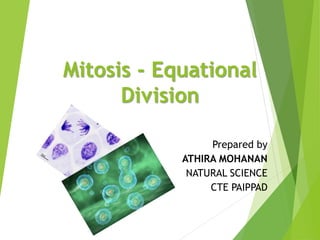
Athira
- 1. Mitosis - Equational Division Prepared by ATHIRA MOHANAN NATURAL SCIENCE CTE PAIPPAD
- 2. Mitosis Definition “Mitosis is that step in the cell cycle where the newly formed DNA is separated and two new cells are formed with the same number and kind of chromosomes as the parent nucleus.”
- 3. What is Mitosis? Cell division is the driving process of reproduction at the cellular level. Most eukaryotic cells divide in a manner where the ploidy or the number of chromosomes remains the same, except in the case of germ cells where the number of chromosomes is halved.
- 4. Mitosis is the phase of the cell cycle where the nucleus of a cell is divided into two nuclei with an equal amount of genetic material in both the daughter nuclei. It succeeds the G2 phase and is succeeded by cytoplasmic division after the separation of the nucleus. Mitosis is essential for the growth of the cells and the replacement of worn-out cells. Abnormalities during mitosis may alter the DNA, resulting in genetic disorders.
- 5. Features of Mitosis In each cycle of cell division, two daughter cells are formed from the parent cell. The cell is also known as equational cell division because the chromosome number in the parent cell and daughter cell is the same. In plants, mitosis leads to the growth of vegetative parts of the plant like root tip, stem tip, etc. Segregation and combination do not occur in this process. The processes occurring during mitosis have been divided into different stages.
- 6. Stages of Mitosis Right before prophase, the cell spends most of its life in the interphase, where preparations are made before the beginning of mitosis (the DNA is copied). However, since the actual process involves the division of the nucleus, prophase is technically the first stage of this process.
- 7. Interphase Before entering mitosis, a cell spends a period of its growth under interphase. It undergoes the following phases when in interphase: G1 Phase: This is the period before the synthesis of DNA. S Phase: This is the phase during which DNA synthesis takes place. G2 Phase: This is the phase between the end of DNA synthesis and the beginning of prophase.
- 8. Prophase Prophase immediately follows S and G2 phase of the cycle and is marked by condensation of the genetic material to form compact mitotic chromosomes composed of two chromatids attached at the centromere. The completion of prophase is characterised by the initiation of the assembly of the mitotic spindle, the microtubules, and the proteinaceous components of cytoplasm that help in the process.
- 9. The nuclear envelope starts disintegrating. Prophase
- 10. Prometaphase In the prometaphase, the nuclear envelop disintegrates. Now the microtubules are allowed to extend from the centromere to the chromosome. The microtubules attach to the kinetochores which allow the cell to move the chromosome around.
- 11. Metaphase At this stage, the microtubules start pulling the chromosomes with equal force, and the chromosome ends up in the middle of the cell. This region is known as the metaphase plate. Thus, each cell gets an entire functioning genome.
- 12. Anaphase The splitting of the sister chromatids marks the onset of anaphase. These sister chromatids become the chromosome of the daughter nuclei. The chromosomes are then pulled towards the pole by the fibres attached to the kinetochores of each chromosome. The centromere of each chromosome leads at the edge while the arms trail behind it.
- 13. Telophase The chromosomes that cluster at the two poles start coalescing into an undifferentiated mass, as the nuclear envelope starts forming around it. The nucleolus, Golgi bodies and ER complex, which had disappeared after prophase start to reappear.
- 14. Cytokinesis Telophase is followed by cytokinesis, which denotes the cytoplasm, organelles and nuclear materials are evenly split and two new cells are formed. The two cells each like the other are called daughter cells. It marks the completion of cell division.
- 15. Functions of Mitosis Following are the two important functions of mitosis: Mitosis helps in the development of an organism. In single-celled organisms, mitosis is the process of asexual reproduction. Mitosis helps in the replacement of damaged tissues. The cells near the damaged cells begin mitosis when they do not sense the neighbouring cells. The dividing cells reach each other and cover the damaged cells.
- 16. Significance of Mitosis Mitosis is responsible for the development of the zygote into an adult. The chromosomes are distributed equally to the daughter cells after each cycle. It is responsible for a definite shape, and proper growth and development of an individual It maintains the constant number of chromosomes in all body cells of an organism.
- 17. In plants, mitosis helps in the formation of new parts and the repairing of damaged parts. Mitosis helps in vegetative propagation of crops also. Since no recombination and segregation occurs in the process, it helps in maintaining the purity of types. It helps in maintaining a balance between the DNA and RNA contents as well the nuclear and cytoplasmic contents of the cell. It is responsible for replacing dead and old cells in the animals: Eg, gut epithelium, and blood cells.